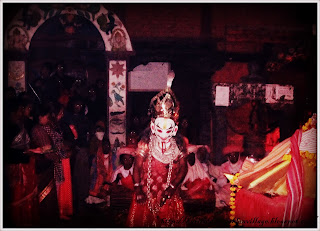Tuesday, December 24, 2013
Tuesday, December 17, 2013
Sunday, December 15, 2013
योमरी पुन्ही (Yomari Punhi)
(मार्ग शुक्ल पुर्णिमा, योमरी पुन्ही)
प्राय: नेवार परिवारहरुमा यस दिन योमरी बनाइन्छ। तर यस गाउँमा योमरी को सत्ता घिउ, चाकु हालेर मन्दिरको आकर आउने गरी ठुल- ठुलो गोजामरी पकाएर आफ्नो भकारीमा राख्ने चलन छ। ३ दिन पछी उक्त गोजामरी निकालिन्छ। यसो गर्नाले भकारीको धान सुक्दैन भन्ने विश्वास रही आएको छ।
यस दिन हरसिदी भवानी को नाच समेत हुने हुँदा गाउँले जात्राको रुपमा मान्दछन् जसलाई योमरी पुन्ही भन्ने गरिन्छ।
प्राय: नेवार परिवारहरुमा यस दिन योमरी बनाइन्छ। तर यस गाउँमा योमरी को सत्ता घिउ, चाकु हालेर मन्दिरको आकर आउने गरी ठुल- ठुलो गोजामरी पकाएर आफ्नो भकारीमा राख्ने चलन छ। ३ दिन पछी उक्त गोजामरी निकालिन्छ। यसो गर्नाले भकारीको धान सुक्दैन भन्ने विश्वास रही आएको छ।
यस दिन हरसिदी भवानी को नाच समेत हुने हुँदा गाउँले जात्राको रुपमा मान्दछन् जसलाई योमरी पुन्ही भन्ने गरिन्छ।
Source: हरसिदी एक संक्षीप्त परिचय
 |
| Yomari |
Yomari Punhi is a post harvest festival celebrated by Newars which falls on the full moon day in
the Nepalese month of Mangsir. During the festival Goddess Annapurna
(the Goddess of Food Grains) is worshipped and sweetmeats are prepared from
the newly harvested rice. Yomari – a sweetmeat of rice flour shaped like a
fig and filled with jaggery and sesame seeds is prepared. This delicacy is the
chief item on the menu during Yomari Punhi.
Source: explorehimlaya.com
Friday, December 13, 2013
Battle between Sugriv and Bali Rāja
At the start of the climactic scene in the pyākhã, the Triśakti
appear center stage, mirrored by the curtain showing their likeness that is
raised to conceal them. Together with Sugrîv, Bali Rāja, and others, the Triśakti
Devis described in the historical accounts are seen by all in their full
regalia with shimmering headdresses, silver chain garlands, breast plates, and
ornate bone aprons. Offering the true pointed sword of siddhi for wisdom and
success, Harisiddhi Triśakti provides the means for Sugrîv to destroy Bali Rāja,
the foolish Demon king of ignorance. Jumping over the special tantric curtain, Sugrîv
leaps directly into the battle scene, sword in hand, to defeat and behead Bali
Rāja.
 |
| Nāgin (Bali Rāja) with halo-like headress and With Tāra, the khowla moca crybaby (right). |
Immediately following this is the celebration of the success, victory,
and renewal of life. Since the Triśakti are all fierce deities, there is a
final pańca bali blood sacrifice including sheep, ducks, fish and buffalo.
While the Triśakti deities are lifted off the ground to drink the blood of each
animal, a separate group of musicians play the pańca baja offering music to
accompany the pańca bali sacrifice.
Order is restored, when and the Betal licks up
the blood. Malini offers flowers to Indra, King of the Gods, and the elephant
Kisi runs freely on the stage.
Sunday, December 8, 2013
Thursday, December 5, 2013
Wednesday, December 4, 2013
Subscribe to:
Posts (Atom)

.jpg)











